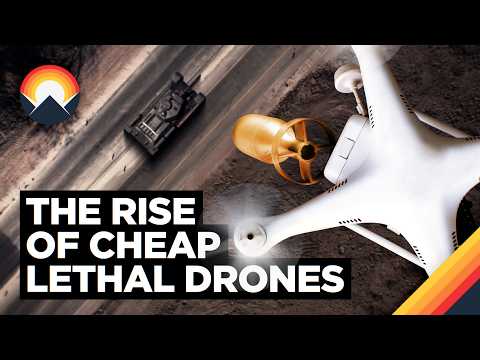The Terrifying Efficiency of Drone Warfare

This is a grainy, sped up, cut up, loud and proud, combat highlight tape released to social media by a Ukrainian military brigade. In the picture are Russian T-72B3M tanks, a refurbished and revamped Cold War staple that Russia has come to rely on during their invasion of Ukraine. All three are doomed, about to be put out of commission by the author of this video, the 79th Air Assault Brigade—a highly trained but highly out-gunned subset of the Ukrainian defense effort. The unit deals with all three tanks through conventional means—weapons and approaches
that have more or less been around since World War II. The first is stopped in its tracks by a mine, an anti-tank mine, while this one, unclear as to why it’s stopped, is hit by an antitank missile or some similar sort of air ordnance. Finally, what struck the second is what strikes and stops the third. Up to this point, if the video were just a bit grainier or black and white, the battle scene could be from 2024, or 1974, or 1944. But the clip isn’t over. These three tanks—at least by their own power—are not going to move again which, for the 79th, means they’ve landed three mobility kills as they’re called in military parlance. But the work’s not done—should they be hauled back behind Russian lines, perhaps they could be fixed, or at least used for parts. So the 79th needs to finish the tanks off. But now they turn to
something novel, something that’s shaped Russia’s invasion and Ukraine’s defense, something that’s quickly becoming a staple in 21st century warfare: drones. Rather than sending troops in to finish off tanks and chase down their operators—which risk the safety of a soldier—or fire artillery or missiles at the sitting targets—which the Ukrainian military has desperately few of—the 79th now mobilizes a fleet of small, inexpensive unmanned aerial vehicles. Here, a fixed-wing drone strapped with an explosive plows into the tank’s weak point to render it useless. Here, another does the same. Here, a drone pilot, rather than tracking on foot, follows the path of hiding Russian soldiers with what’s in all likelihood a quad-copter equipped with a grenade. Here, the same. And, when zooming out to consider what made this possible—spotting the quickly moving enemies approaching first, then filming it all to cut the prideful 1-minute, 27-second piece later—it’s again a drone, this of the more expensive military-grade variety. And these 90 seconds serve as a microcosm—drones are no small part of what’s kept Ukraine in the fight for this long and they’re a big part of why the 79th still exists at all.
Consider the context of this clip—it’s shot somewhere around here on the front lines in the hotly contested Donbas region near Donetsk. For years now, the 79th Air Assault Brigade has been battling over this region—in particular over this village, Marinka. Once home to 9,000, Marinka is now a ghost town with few structures still standing. It’s a spot that Ukraine
and Russia grappled over for 20 months before it finally fell to the invaders in late 2023. And to some educated onlookers and strategists, its fall was cause for concern. Now, it seemed Russia would have easier access to Ukraine’s interior by way of the city of Kurakhove just 10 miles or 16 kilometers west down O0510 Road. But in more than 6 months of trying and 14 coordinated efforts to break through, Russia’s been rebuked—because of brave, well-trained soldiers, and because: drones. In fact, most of these thwarted efforts play out in a strikingly similar manner to the earlier clip. Just 11 days prior to the 79th releasing the video of the three
ill-fated T-72s, they posted this video. And 9 days prior to that, they posted this one. In each, drones, like Ukraine itself, are punching far above their commercial-grade weight. And they’ve been doing so since the very first days of the invasion—it just looked a bit different. First it seemed the Turkish-produced Bayraktar TB2 might carry the day. Capable of staying aloft for up to 27 hours, carrying a payload of up to 330 pounds or 150 kilograms, these weren’t cheap, as Ukraine purchased six of the drones, along with three control stations in 2019 for about $69 million dollars. It was worth the investment initially. As early as 2021, they patrolled the Donbas region and even fired on a separatist position. Then, in February,
with the invasion beginning, they quickly reached legendary status—successfully firing on tanks, fuel trains, fighting vehicles, and missile systems, the TB2 quickly gained a reputation in the invasion’s early stages. By April, they were now sinking ships while Ukrainian troops sang—and Ukrainian radio played—the Bayraktar song as the Turkish drone had become a central figure of Ukrainian resistance. The world took notice, too, as The New Yorker even went so far as to publish a story titled “The Turkish Drone That Changed the Nature of Warfare.” Then something changed.
Specifically, the global attention on the TB2 extended to Russia, which after anchoring more defense positions near and within Ukraine’s borders, directed more attention to and surface-to-air missiles at the relatively slow, relatively low-altitude, and relatively expensive drones, effectively blasting them off the front-lines and into more minor observational roles. High-dollar drones worked, but they didn’t play to Ukraine’s advantage—its resourcefulness and conviction in the role of the defensive combattant—nor recognized the gap in available resources between them and Russia. Fighting with, and inevitably losing such expensive equipment played into Russia’s hands. But rather than pivot entirely away from UAVs, they iterated, moving away from the military-grade, million dollar drones for the unassuming sort; the commercial, cheap, easy-to-operate, and easy to produce quadcopters. While DJI, the world’s most renowned commercial quadcopter producer, has never made a military-grade drone, and has no interest in its products being used, sold, or thought of as weapons, they’ve become exactly that in the 21st century’s most significant ground war to date. In October of 2023, the country’s prime minister Deny Shmyhal claimed that Ukraine had gotten their hands on some 60% of the company’s global output of Mavic quadcopters. These drones, DJI or otherwise, play squarely to Ukraine’s strengths. For one, they just don’t cost much—they retail at under a thousand dollars. Used
as small-area scouts, they also play to the advantage of the defender rather than the aggressor, as any advance, build up, or really any disturbance on the frontlines becomes easy to monitor via drone while the operator maintains their cover. They also help mitigate Ukraine’s ammunition deficiency, as a drone can scout targets—while a TB2 can spot a potential target miles away, a quadcopter can fly near enough to make sure it is indeed worth the in-demand artillery shells to attack. And this technology has helped Ukraine undercut mighty Russia’s greatest fighting strength: its sheer scale. With the advent of such accurate, unrelenting monitoring of every movement, Russian forces have had to adjust, moving in smaller numbers more quickly, which, for a fighting force known for prevailing by force but consistently plagued by organizational issues, is a big ask. And for a fighting force constantly in need of supplies, drones are uniquely easy to crowdsource —Ukrainian citizens have been happy to donate their hobby drones to the cause, and so too have citizens across the heavily sympathetic West. But if the idea of repurposed quadcopters was resourceful on the part of Ukraine, then the advent of mass-produced kamikaze drones is nothing short of scrappy.
Mechanically, there’s a good few differences between reconnaissance quadcopters and kamikaze drones—some of the latter are fixed wing, a vast majority are piloted by fixed camera first-person-viewing-systems, and increasingly these are manufactured strictly for military purposes within the borders of Ukraine. But the biggest difference is that these aren’t capable of carrying, then dropping, a payload, they are the payload. On an economic scale, these make obvious sense. Consider the earlier example of kamikaze drones ramming into the weak points in downed tanks. Now, it’s difficult to boil down the exact unit cost of a T-72; they cost a couple million per when built during the Soviet era, and they cost over $200,000 each to ramp up for the standards of modern warfare. But whatever the cost, the
math remains simple, as the oft-cited going rate for a first-person-view kamikaze drone is about $400. Suddenly, the playing fields of an asymmetrical conflict becomes a bit closer to level. And this goes for human capital, too. Ukrainian troops on the eastern end are outnumbered by orders of magnitude by Russian soldiers, so anytime a DJI Mavic can search the fields surrounding Marinka for retreating Russians, or a quadcopter can drop a payload big enough to finish off a soviet-era tank, Ukraine keeps another soldier out of harm’s way. Across what’s nearing three years of innovating and iterating, drones have become central and fundamental in Ukraine’s defense. And its military knows it. Just take the 79th air assault brigade’s website: there’s soldiers, there’s a helicopter, and there’s a drone. And, should one view the brigade’s listed vacancies, they’re looking to hire more drone pilots at a wage competitive to the rest of their open positions. The brigade has even gone so far as to create an attack drone
company to flank its more traditional tank company and attack battalions. And along with more pilots, they need more drones, something that battalion members have posted on YouTube, and something that American 501c3’s have latched on to as an easy way to help the cause, with groups like Ukrainian Defense Support publishing explainers on how to get all important drones from American consumer’s hands to Ukrainian soldiers. But the cycle of military innovation is predictable, and the next stage after a novel technology opens up an asymmetrical advantage is the development of countermeasures. In this case, some of the countermeasures are stupidly simple. For example: nets. The exposed rotors of commercial quadcopters will quickly seize up when in contact with just about anything, so simple netting is enough to stop them in their tracks. So facing the new threat, Russia has adorned all their key infrastructure near the front line with so-called anti-drone netting, and it’s working. In addition,
they’ve experimented with building metal cages around high-value vehicles and weapons to at least minimize damage from kamikaze drones—keeping the blast further away from fragile components. But then there’s the offensive option. The sorts of sub-$1000, commercial drones used in this war have rather limited flight time—between 20 and 30 minutes—and even more limited signal range—often as little as a mile. While there are ways to reduce these limitations, operating kamikaze drones always requires the operator to be effectively on the front line. Therefore: drone on drone warfare. Observing their effectiveness, Russia has built up an
equally-strong drone capability, backed by a burgeoning domestic manufacturing industry. Along the front line, operators from both sides now hide in makeshift bunkers, peaking out momentarily to launch their aircraft on a mission to hunt out their counterparts just miles away. Finding and destroying an enemy drone base is now a prime objective of each side as it has the ability to immobilize a whole fleet of potentially destructive drones, rather than just one tank or truck or soldier. But perhaps the most effective countermeasure is signal jamming. Cheap commercial drones rely on GPS to navigate, but fundamentally what a GPS
signal is is a rather weak radio wave broadcast from a satellite in space. Therefore, all it takes to disrupt GPS navigation is broadcasting a different, incorrect signal on the same frequency. This is what GPS jamming is, and it’s now rampant in hotly-contested areas. And the same principles apply for essentially any other form of wireless communication. It's all just radio waves of different frequencies, so if Russia knows what frequency Ukrainian drones use to communicate with their operator, which is fairly predictable if they’re using popular commercial drones, they can simply overwhelm that frequency with irrelevant radio waves, forcing the drone to lose signal and crash. This sort of electromagnetic warfare has turned the drone war into a game of cat and mouse. One side develops a signal jammer capable of interfering with the frequency used by the other side’s drones, so the other side develops drones that communicate using a different frequency, then the first side adapts their electronic warfare capabilities, and so on and so on. The net effect is that drones have gotten less effective for both sides. The likelihood of
a given drone successfully destroying an enemy asset has steadily declined, and therefore that incredible efficiency that made headlines in the early days of the war is quickly diminishing. But there’s an obvious solution, and it's seen in this short clip. These red boxes represent the first days of a new epoch of warfare. That’s because this drone, developed by startup Ukrainian company Saker, is autonomously identifying targets. Within each box is what a computer vision algorithm believes is a target that could be strategically beneficial to destroy, while the text above indicates what, in particular, it thinks it is, and the number to its right is an indication of the software’s confidence in what it believes it sees. The short-term benefit of autonomy is straightforward: Russia’s most effective countermeasure is to interrupt the signal between a drone operator and a drone, so what if the drone doesn’t need a signal? What if the drone, once deployed, could independently navigate to, identify, and strike a target. Or even: what if it could determine its target and decide to strike it
itself without any authorization by an operator? While all indications suggest that there’s not yet wide-scale use of AI drones in Ukraine, Saker’s scrappy autonomous drones have reportedly already destroyed Russian targets in autonomous mode, meaning the era of AI warfare has quietly begun. In practice, autonomous drones have yet to make a major impact in the war as they still require human involvement, they’re rather finicky, and they’re more costly than equally destructive conventional equivalents—but 6,000 miles away, on the other side of the Atlantic, in an industrial area next to an Ikea in Costa Mesa, California, one company is trying to change that. Its name is Anduril. Anduril’s heritage explains a lot. Its founder, Palmer Lucky, was the pioneer behind the Oculus brand of VR headsets. While still a teenager he grew this into a burgeoning company and eventually sold it to Facebook for $2 billion at just 21-years old. During these years, others that would eventually join Anduril were working at SpaceX and Palantir. The significance of this pair of companies is in the fact that
they effectively built the Anduril business-model. That’s because the rocket-launch and predictive analytics companies each took the US government on in court when they believed they were being shut-out of competitive bidding for US military contracts in favor of the old-guard of the military-industrial complex like ULA or Raytheon. Each of these companies believed the US military procurement system was broken, and this belief was well-grounded. After all, the United Launch
Alliance was paid to keep operating a wildly inefficient and aged Atlas V launch system for decades, with absolutely no incentive for innovation in a way that might bring down cost for the government. That’s because, like many military contracts, ULA was paid on a cost-plus basis, meaning they were paid whatever it cost for them to do the work they were asked to do, plus a fixed percent for profit. In many ways, this actually disincentivized innovation since creating a more efficient system that cost less per-launch would actually reduce their fixed profit percentage. But SpaceX wasn’t getting these contracts anyways, so their solution was to foot the cost of innovation themselves, develop a more efficient launch system, then enter a competitive bidding process to offer space access at a lower cost, yet still turn a profit. After some legal tussles, this worked, the government had effectively no choice but to accept their proposal to do the same work for less, and they’ve now grown into the largest launch provider for the US.
Anduril was formed under the same model—that of a traditional company, rather than a military contractor. But rather than work on the fringes of the industry, competing in the space-launch or predictive analytics spaces, which have plenty of private customers, Anduril is taking the old-guard head-on—developing innovative products that are generations ahead of what the legacy contractors are offering, exclusively for the US and allied militaries, under the belief that their offerings will be just too good to pass up. At the core of that value-proposition is artificial intelligence. They seem to recognize the shortcomings of early autonomy in Ukraine—fundamentally, that the full potential of autonomous drones is stymied by the persistent one operator to one device equation. Just as vehicle autonomy is still merely a convenience rather than the promised generation-defining breakthrough due to the need for human oversight, drone autonomy won’t either until it’s able to unlock unimaginable degrees of volume. That’s why Anduril’s marquee product is Lattice—this is essentially an operating system… for war.
This promotion video demonstrates how Lattice is supposed to work. In this mock scenario, a combatant drone is detected by the company’s Sentry product—one of its first, originally deployed along the US-Mexico border as part of a contract with US Customs and Border Protection. Sentry then alerts an operator, who elects to activate Pulsar—Anduril’s electromagnetic warfare solution, capable of jamming communication signals to and from the drone. But next we see the launch
of Anvil—their kinetic interceptor drone or, put another way, the drone built to smash into other drones. Each of these devices work autonomously, yet are strung together into an integrated system by Lattice. And Anduril’s has plenty more products to add to that system—a jet-powered interceptor, an infrared surveillance platform, and a wide variety of other airborne platforms.
This is what unlocks the full potential of drones. Highly capable drones are now cheap, but human operators are not. So by stringing together autonomous drones with an operating system, both the drones and the operation of drones is cheap. This is where capabilities really compound. Destruction in warfare typically follows certain rules. A grenade might be cheap and destructive, but it’s not very capable—it requires close proximity. A guided missile might
be destructive and capable, but it’s not very cheap—its manufacturing is extraordinarily expensive. A single kamikaze drone might be cheap and capable, but it’s not very destructive—it can possibly destroy a tank, but with lowering success rates it’s really that a single drone can destroy, on average, say, a tenth of a tank. Interconnected, autonomous drones, however, are cheap, capable, and massively destructive. And that’s largely thanks to drone swarms. Without
the need for operators in close proximity for each aircraft, a military could deploy dozens, hundreds, even thousands of drones without a risk to human life on their side before getting to the cost of a single advanced precision-guided missile. That’s to say: the cost of killing is getting scarily low. And then there’s one other key difference—to date, essentially every life taken in war has been the direct result of a decision made by another human. Human judgment determines death. But soon, artificial intelligence algorithms might. Humans
will decide to deploy a drone, but a drone will be capable of independently determining whether a life is worth taking. So that’s to say, in addition to removing the monetary and human cost of killing, autonomous drones also remove the moral cost—nobody has to bear the weight of pulling the trigger that ends a life. Killing should have friction, it should be costly, it should feel terrible. This new era of warfare unlocks apocalyptic levels of efficiency in death. It is often the case that early observers overestimate the potential calamity
that new military innovation will bring—the long-term average is that reality is not as bad as we fear—but there is a fear that this time might be different. Drone warfare has precedent—we’ve seen how militaries act when they have access to risk-free killing anywhere in the world with multi-million dollar drones manufactured by major contractors. Some of the most horrific actions by the US military have happened outside the context of a formal war through the use of remotely-operated aircraft. Civilian casualties have been enormous, and the state of war is now a blurry, near-perpetual concept—strikes happen indiscriminately in countries with which the US has no active state of war. Now, we’re entering an era where this same technology can be acquired on a miniaturized scale not from military contractors, but from online retailers. So
the concern is twofold. First, what will non-state actors—terrorists, cartels, and others with a will to kill—do with a technology that allows them to transport an explosive device effectively anywhere, at limited risk or cost to themselves. And second, with the expanded capabilities of massive swarms of drones, what will state actors do when the accountability and friction of war is minimized to perhaps its lowest level ever. As this video makes clear, artificial intelligence is becoming quite influential—it is the key technology around which the next generation of weapons is being built. When any technology becomes this influential, I believe it’s important
to have an understanding of how it actually works, and the best place to do so is our sponsor, Brilliant.org. That’s because one of their courses is called “Introduction to Neural Networks.” This is the exact tool being used in Ukraine right now to aid drone pilots in identifying targets, and in this course Brilliant.org helps you go from nothing to having a decent understanding of the inner workings of this tech. They do so by breaking the subject down into small,
intuitive principles, then teaching these through interactive exercises and straightforward visuals. Then, as you move on, they bring these concepts together and soon enough, you grasp the overall subject. It really is a better way of learning, and they have these excellently designed courses for dozens of STEM-related subjects so if you’re the kind of person who enjoys having an understanding of how things work, Brilliant.org is an excellent resource to get a grasp of these subjects that are tough to learn outside the context of formal education. They really just make it practical, as you can progress on their courses either on the computer or their mobile apps, and a given section only takes 15 minutes or so, so you can make progress in understanding, say, gravitational physics just while waiting for the subway. And best of all, you can try everything Brilliant has to offer for free for a full 30 days. Just visit Brilliant.org/Wendover
or click on the link in the description. You’ll also get 20% off an annual premium subscription, and help support this channel, so thanks in advance for checking them out.
2024-08-10 18:14


